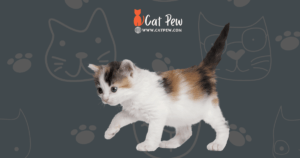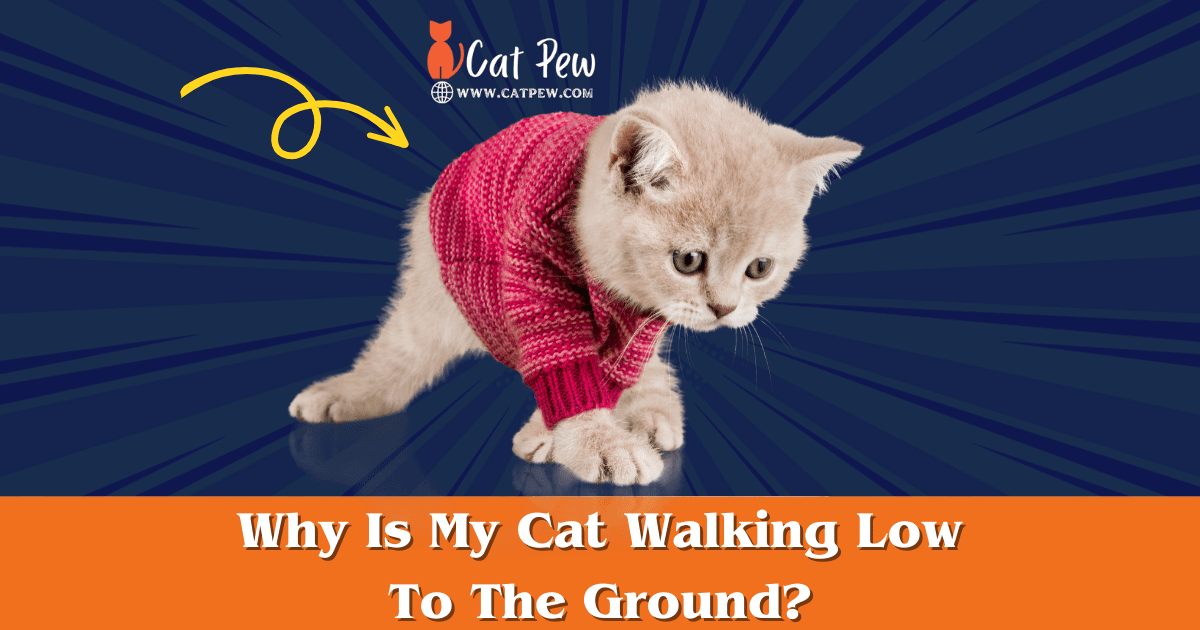There are several reasons why your cat may be walking low to the ground. It could be a sign of fear, pain, discomfort, or a predatory instinct.
When cats walk low to the ground, it may indicate that they are feeling threatened or anxious. By staying closer to the ground, they adopt a defensive posture to make themselves appear smaller and less vulnerable. This behavior can also be seen in outdoor cats when they are stalking prey.
In some cases, walking low to the ground could be a response to pain or discomfort, especially if your cat is experiencing joint or muscle issues. If you notice this behavior persisting or if your cat shows signs of distress, it’s crucial to consult with a veterinarian to determine the underlying cause.
Understanding The Behavior Of Cats

Cats are fascinating creatures with a range of behaviors that sometimes leave us mystified. As cat owners, we need to understand and decode their actions to ensure their well-being. One peculiar behavior we often come across is when our cat walks low to the ground. In this article, we will explore why cats display this behavior and what it signifies in the feline world.
To understand why cats walk low to the ground, we need to delve into their instincts and behaviors. Despite being domesticated, cats often retain their primal instincts inherited from their wild ancestors. One such behavior is their instinctual hunting technique. When cats are on the prowl for prey, they tend to crouch low, near the ground, to remain inconspicuous and ready to pounce.
| Natural Instincts | Behaviors |
|---|---|
Predatory instincts
|
|
This instinct can give us insight into why our cat may be walking low to the ground. By adopting a lowered posture, they could be honing their hunting skills, even if the prey happens to be a beloved toy or a random object that caught their attention. It’s an instinctual behavior ingrained in their DNA, reminding us of their innate connection to the wild.
Apart from their hunting instincts, a cat’s posture and body language can serve as valuable cues to understanding why they are walking low to the ground. In the feline world, body language is a primary means of communication. By observing their posture and movements, we can decipher their intentions and emotions.
- Arched back: When a cat walks low to the ground, their back may be arched. This indicates that they are feeling threatened or defensive. It’s their way of making themselves appear bigger and more intimidating to any potential threat.
- Flattened ears: Another body language cue to look out for is flattened ears. When your cat’s ears are held close to their head, it suggests they are feeling anxious or fearful. By walking low, they are trying to make themselves inconspicuous and avoid any unnecessary confrontations.
- Slow and deliberate movements: Cats tend to move slowly and deliberately when they are in predator mode. By walking low to the ground, they can carefully survey their surroundings and plan their next move with precision.
By paying attention to these distinctive body language cues, we can better understand why our cat is walking low to the ground. It’s essential to create a safe and comforting environment for our feline companions to help them feel secure and reduce any unnecessary stress or anxiety.
The Significance Of A Cat Walking Low To The Ground

When your cat walks low to the ground, it may be a sign of fear, anxiety, or pain. Observing their body language and seeking veterinary advice can help determine the cause and ensure their well-being.
Common Reasons For A Cat Walking Low
There are several common reasons why a cat may be seen walking low to the ground. Understanding these reasons can provide valuable insight into your feline friend’s behavior and well-being.
- Pain or discomfort: One of the primary reasons a cat may walk low to the ground is if they are experiencing pain or discomfort. This can be due to various factors such as injuries, arthritis, or even dental problems. Cats have an instinct to protect their vulnerable areas when in pain, so they may hunch down closer to the ground.
- Illness or injury: Similar to experiencing pain, cats may walk low to the ground if they are unwell or recovering from an injury. When they feel weak or vulnerable, they may adopt a lower posture to conserve energy and minimize strain on their body.
- Sign of submission: Cats are known for their territorial nature, and in some cases, walking low to the ground can be a sign of submission. This behavior is often displayed when a cat is in the presence of a dominant cat or person.
- Aggression or hunting mode: On the other end of the spectrum, a cat walking low to the ground can also indicate a heightened state of aggression or hunting mode. When they are ready to pounce on their prey, cats may lower their bodies for better stability and leverage.
- Territorial marking: Cats have scent glands located on their paws, and walking low to the ground can help them leave their scent on surfaces, marking their territory. This behavior is often seen in outdoor cats who are claiming their space.
The Role Of Fear And Anxiety In A Cat’s Behavior
Fear and anxiety can significantly impact a cat’s behavior, leading to a lower walking posture. Cats are known to be sensitive creatures, and various factors can trigger anxiety in them.
When a cat feels threatened or scared, their natural response is to adopt a defensive stance, which often involves walking low to the ground. This behavior serves as a way for them to make themselves appear smaller and less noticeable, helping them navigate through potentially dangerous situations.
Additionally, cats may experience anxiety due to changes in their environment, such as moving to a new home, introduction of new pets, or disruptions in their routine. These stressors can affect their confidence and cause them to adopt a lower walking position.
As a responsible cat owner, it is essential to create a safe and comforting environment for your feline companion to reduce the likelihood of fear and anxiety. Providing hiding spots, engaging in interactive play, and maintaining a consistent routine can help alleviate these negative emotions and encourage a more confident posture.
Possible Health Issues Associated With Low Walking In Cats

When it comes to our beloved feline companions, it’s essential to pay close attention to any changes in their behavior or movement. One concerning sign is when your cat starts walking low to the ground. This unusual gait can indicate various health issues that require further investigation and veterinary care. In this article, we’ll explore some possible health issues associated with low walking in cats, including arthritis and joint pain, injuries or sprains, and neurological disorders affecting mobility.
Arthritis And Joint Pain
Cats, just like humans, can experience arthritis and joint pain as they age. This chronic condition affects their joints, leading to discomfort and reduced mobility. When your cat walks low to the ground, it may be an indication of joint pain or stiffness. Arthritis commonly affects the hips, knees, and spine, causing cats to adopt a low and hunched posture to alleviate the pain. Keep an eye out for other signs such as difficulty jumping, reluctance to climb stairs, or a decrease in overall activity level. If you suspect arthritis, consult with your veterinarian for a proper diagnosis and appropriate treatment options.
Injuries Or Sprains
Cats are known for their agility and acrobatic skills, but accidents can happen. Injuries or sprains to their legs, paws, or back can cause your cat to walk low to the ground. These types of injuries may occur from falls, jumps, or vigorous playtime. If your cat has experienced trauma or if you notice signs of pain, such as limping or favoring a particular leg, it’s crucial to seek veterinary attention promptly. Early intervention can help prevent further damage and aid in a speedy recovery. The vet may recommend rest, medication, or even physical therapy to help your cat regain their mobility.
Neurological Disorders Affecting Mobility
Neurological disorders can also contribute to a cat’s low walking stance. Conditions such as spinal cord injuries, nerve damage, or coordination problems can cause weakness and loss of balance. Additionally, certain diseases, like Feline Cerebellar Hypoplasia, can affect a cat’s motor skills, making them walk low to the ground. If you observe your cat stumbling, dragging their paws, or showing signs of disorientation, it’s essential to consult with your veterinarian. Identifying and managing underlying neurological disorders can greatly enhance your cat’s quality of life.
| Signs of possible health issues: |
|
It’s important to remember that each cat is unique, and their symptoms may vary based on the underlying health issue. If your cat exhibits any of these signs or if you have concerns about their low walking stance, it’s crucial to consult a veterinarian for a proper diagnosis and treatment plan. Remember, early detection and intervention can make a significant difference in your cat’s well-being.
Environmental Factors Contributing To Cats Walking Low

When our beloved feline companions start walking low to the ground, it can be a cause for concern. Cats are known for their graceful and agile movements, so a change in their gait may indicate that something is amiss. While there are several potential reasons why a cat may walk low, one significant factor to consider is their environment. The surroundings in which a cat lives can play a crucial role in their behavior and overall well-being. Let’s explore some of the environmental factors that may contribute to cats walking low.
Uneven Surfaces And Slippery Floors
One potential environmental factor that can cause cats to walk low is the presence of uneven surfaces and slippery floors in their living space. Cats rely heavily on their balance and coordination, and when they encounter surfaces that are difficult to navigate, it can result in a cautious and low-to-the-ground walking style.
Lack Of Proper Perching And Climbing Spots
Cats are natural climbers and love to perch on elevated spots. Having access to proper perching and climbing spots is essential for their physical and mental stimulation. When these opportunities are limited or absent from their environment, cats may resort to walking low in an attempt to maintain a sense of security and control.
Presence Of Other Dominant Cats Or Predators
Cats are territorial animals, and their sense of safety and confidence can be influenced by the presence of other dominant cats or potential predators in their surroundings. If a cat feels threatened, they may adopt a low walking posture as a defensive mechanism to make themselves less visible and appear submissive.
Behavioral And Psychological Factors Affecting Cat Walking

When it comes to understanding our feline friends, their behavior and psychology play a crucial role. Many cat owners may notice their pets walking low to the ground at times, and this can be attributed to various behavioral and psychological factors. Understanding these factors can help us better care for our cats and ensure their well-being. In this article, we will delve into the different reasons why cats exhibit this behavior, such as defensive behavior due to a perceived threat, submission or submission-related anxiety, and depression or stress in cats.
Defensive Behavior Due To A Perceived Threat
Cats are known for their elusive and independent nature, but they can also be quite territorial. When they sense a threat or danger in their environment, they may adopt a low-to-the-ground walking posture as a defensive mechanism. This defensive posture allows them to appear smaller and less threatening, making it easier for them to hide or retreat if necessary. It’s their way of expressing caution and asserting their boundaries.
Submission Or Submission-related Anxiety
Submission or submission-related anxiety is another reason why cats may display low-to-the-ground walking behavior. Cats are social animals, but they also have a hierarchical instinct. If they perceive a dominant or aggressive individual in their vicinity, they may adopt a submissive
Approaches To Help Your Cat If They Walk Low

Is your cat walking low to the ground? Observing this behavior in your furry friend can be concerning. However, there are several approaches you can take to help your cat if they are walking low. By creating a safe and enriched environment, providing regular exercise and playtime, and consulting with a veterinarian or behaviorist when needed, you can support your cat’s well-being and address this behavior effectively.
Creating A Safe And Enriched Environment
A safe and enriched environment is essential for cats, especially if they are walking low to the ground. Here are some steps you can take:
- Provide vertical space: Cats love to climb and perch, so make sure your home offers plenty of vertical space. This can include cat trees, wall-mounted shelves, or even designated perching spots on furniture.
- Offer hiding spots: Cats feel safe when they have hiding spots to retreat to. Provide them with cozy hiding places such as covered beds, enclosed cat houses, or even cardboard boxes.
- Ensure litter box accessibility: Make sure your cat’s litter box is easily accessible, clean, and in a quiet area. Cats may walk low to the ground if they feel anxious or uncomfortable using their litter box.
- Provide scratching posts: Scratching is a natural behavior for cats and helps them mark their territory. By providing appropriate scratching posts, you can help alleviate stress and prevent low walking behavior.
- Offer interactive toys and puzzles: Keeping your cat mentally stimulated is important. Interactive toys, treat-dispensing puzzles, and even simple household items like paper bags can provide entertainment and enrich their environment.
Regular Exercise And Playtime
Regular exercise and playtime are crucial for cats to maintain a healthy lifestyle. When a cat walks low to the ground, it may be a sign of pent-up energy or boredom. Here are some ways to address this:
- Engage in interactive play: Use toys like feathers, laser pointers, or wand toys to engage your cat in interactive play sessions. This not only helps them burn off excess energy but also strengthens the bond between you and your feline companion.
- Encourage physical activity: Provide opportunities for your cat to engage in physical exercise. This can include setting up obstacle courses, encouraging them to chase toys, or even installing window perches to allow them to watch birds and outdoor activities.
- Set a routine: Establish a daily routine that includes dedicated playtime. Cats thrive on consistency, and providing a structured schedule can help reduce anxiety and prevent low walking behavior.
Consultation With A Veterinarian Or Behaviorist
If your cat continues to walk low to the ground despite your efforts to create an enriched environment and provide regular exercise, it may be beneficial to consult with a veterinarian or behaviorist. These professionals can assess your cat’s overall health and behavior, identify any underlying medical concerns, and provide tailored advice to address the issue. They may recommend behavior modification techniques, dietary changes, or even medication, if necessary.
Remember, each cat is unique, and what works for one may not work for another. By implementing these approaches and seeking professional guidance when needed, you can help your cat overcome walking low to the ground and ensure their overall well-being.
Tips For Communicating And Bonding With Your Cat

If your cat is walking low to the ground, it could be a sign of fear or insecurity. To communicate and bond with your cat, create a safe and comfortable environment, spend quality time together, and use positive reinforcement techniques to build trust and confidence.
Is your cat walking low to the ground lately?
Cats have a unique way of communicating, and their body language can give us valuable clues about their emotions and needs. Understanding and bonding with your cat requires patience, observation, and the right techniques. In this post, we’ll explore some effective tips to establish trust and strengthen your relationship with your feline friend.
Establishing Trust Through Positive Reinforcement Techniques
Building trust is essential for a healthy relationship with your cat. Positive reinforcement is a powerful tool for encouraging good behavior and strengthening the bond between you and your feline companion. Here are some techniques you can implement:
1. Reward-based Training: Positive reinforcement involves rewarding desired behaviors to encourage their repetition. When your cat exhibits good behavior, such as walking confidently or using the litter box, reinforce it with a treat, a gentle pat, or verbal praise. Over time, they’ll associate the behavior with a positive outcome.
2. Clicker Training: Clicker training is an effective method that utilizes a clicker as a marker for desired behavior. The sound of the clicker is immediately followed by a treat, associating the click with a positive reward. By consistently using the clicker and treats, you can teach your cat new behaviors and further build trust.
3. Consistency and Patience: Consistency is crucial in reinforcing positive behaviors. Be patient and persistent while training your cat. It may take time for them to understand what you expect of them, so avoid punishment or yelling, as it can erode trust and cause stress.
Understanding And Responding To Their Body Language
Cats have a complex repertoire of body language that reveals their emotions and intentions. By paying attention to their cues, you can better understand their needs and establish a deeper connection. Here are some common feline body language signals and how to respond to them:
1. Tail Position: The positioning of a cat’s tail can indicate their mood. A relaxed tail held upright is a sign of contentment, while a low or puffed-up tail may indicate fear or aggression. Respect their boundaries accordingly, and give them space when they’re exhibiting signs of stress.
2. Ears: A cat’s ears can convey emotions. Ears pointing forward suggest attentiveness, while flattened ears could indicate fear or aggression. If your cat is showing signs of anxiety, try to identify the cause and remove them from the stressful environment.
3. Purring and Body Rubs: Purring is often associated with happiness and contentment. When your cat approaches you with a gentle body rub, it’s a sign of affection. Respond by giving them gentle strokes or engaging in interactive play to foster a stronger bond.
Building A Strong Bond Through Interactive Activities
Engaging in interactive play is a fantastic way to bond with your cat while providing mental stimulation and exercise. Here are some activities you can incorporate into your daily routine:
1. Interactive Toys: Invest in puzzle toys, feather wands, or laser pointers to keep your cat entertained. These toys encourage them to use their instincts, providing both physical and mental stimulation.
2. Hide-and-Seek: Hide treats or toys around your home to create a scavenger hunt for your cat. This game taps into their hunting instincts while keeping them active and engaged.
3. Cat TV: Set up a window perch or a bird feeder outside to create a captivating “cat TV” experience. Watching birds or other outdoor activities can be an excellent source of entertainment for your curious friend. Remember, each cat is unique, and it’s important to adjust your techniques to match their personality and preferences. By practicing positive reinforcement, understanding their body language, and engaging in interactive activities, you can strengthen the bond with your cat and create a fulfilling and harmonious relationship.
Frequently Asked Questions Of Why Is My Cat Walking Low To The Ground
Question 1: Why Is My Cat Walking Low To The Ground?
When a cat walks low to the ground, it may indicate fear, pain, or illness. It could be a defensive behavior to stay hidden or protect itself. However, it is essential to monitor their behavior closely and consult a veterinarian if you notice any concerning symptoms or changes in their gait or posture.
Question 2: Is It Normal For Cats To Walk With Their Belly Close To The Floor?
Yes, it’s normal for cats to walk with their belly close to the floor when they are stalking or hunting.
Question 3: Are There Any Health Issues Associated With A Cat Walking Low To The Ground?
A cat walking low to the ground could be a sign of underlying health issues such as arthritis or pain.
Question 4: How Can I Determine If My Cat’s Low Walking Is Due To Fear?
If your cat’s low walking is accompanied by flattened ears, dilated pupils, or hiding behaviors, it could be due to fear.
Question 5: Can I Help My Cat If It Walks Low To The Ground Due To Fear?
Yes, creating a safe and calm environment for your cat and using positive reinforcement training can help alleviate fear-related walking behavior.
Question 6: Should I Be Concerned If My Cat Walks Low To The Ground While Playing?
If your cat is playing and showing no other signs of distress, there is usually no cause for concern.
Question 7: Why Does My Cat Walk Low To The Ground When It Sees Other Animals?
Cats may walk low to the ground when they see other animals as a way to appear less threatening or to prepare for a potential chase.
Question 8: Can I Train My Cat To Walk Normally Instead Of Low To The Ground?
While you can train your cat to walk on a leash or follow certain commands, their natural walking behavior may not change significantly.
Question 9: Are Certain Cat Breeds More Likely To Walk Low To The Ground?
No specific cat breeds are more likely to walk low to the ground. It can vary based on individual personality and experiences.
Question 10: When Should I Seek Veterinary Advice About My Cat’s Low Walking?
If your cat’s low walking is accompanied by other concerning symptoms, persists for an extended period, or if you’re unsure about the underlying cause, it is recommended to consult a veterinarian.
Conclusion
To conclude, if your cat is walking low to the ground, it could be due to various reasons including pain, fear, or illness. Observing your cat’s behavior and seeking veterinary advice is crucial in determining the underlying cause. By addressing any potential health issues and providing a safe and comfortable environment, you can help your cat return to a normal walking posture.
Remember, the well-being of your furry friend should always be a priority.

Jonathon
I love cats, I have more than 10 years of experience in raising cats. I want to share with everyone useful knowledge about cats.

